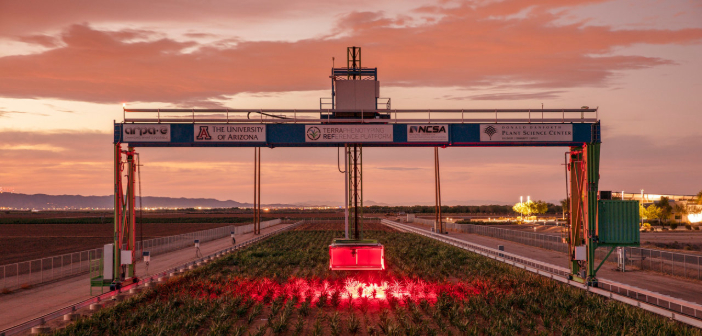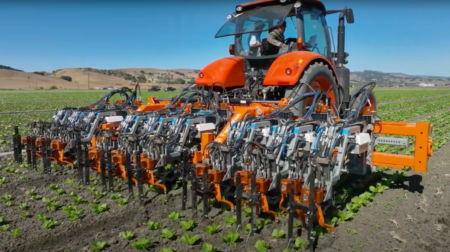Scientists in Arizona are using a 30-tonne robotic field scanner to study plant genetics and possibly develop stress-resilient crops to help combat climate change and develop biofuels.
At 70ft-tall, 92ft-wide and 1,200ft long, the Field Scanalyzer is the world’s largest agricultural robot, the project’s researchers have claimed. Resembling a gantry with a sensor box positioned in the middle, it tends daily to two acres of crops including sorghum, lettuce and wheat, while a cluster of cameras and 3D scanners assess their temperature, shape and hue, and the angle of each leaf.
Funded by the US Department of Energy and the Bill and Melinda Gates Foundation, the Field Scanalyzer is currently being tested in Maricopa, Arizona, from where it sends as much as 10TB of data per day to computers in Missouri and Illinois. Scientists at George Washington University and St Louis University are using AI systems including machine-learning and deep-learning algorithms to analyse and draw conclusions about the plants.
The innovation is described as “an automated robotic field phenotyping platform for detailed crop monitoring”. Phenotyping is the process of predicting a crop’s phenotype – the observable physical properties of an organism – using only genetic information collected from genotyping or DNA sequencing.
This means the robot, which has been developed by German company LemnaTec, can tell whether an organism is the crop that should be there or if it’s an alien, such as a weed or bug – and, therefore, whether it should be eliminated or not. It can also provide information about the quality of the crop being grown.

Rothamsted Research, a UK-based non-profit research centre that focuses on strategic agricultural science, is also supporting the development of the Field Scanalyzer. Researchers from the organisation, Nicola Virlet, Pourla Sadeghi Tehran, Malcolm Hawkesford, and Kasra Sabermanesh, recently explained the thinking behind the Field Scanalyzer, in an academic paper.
“Current approaches to field phenotyping are laborious or permit the use of only a few sensors at a time,” they wrote.
“In an effort to overcome this, a fully automated robotic field phenotyping platform with a dedicated sensor array that may be accurately positioned in three dimensions and mounted on fixed rails has been established, to facilitate continual and high-throughput monitoring of crop performance.
“Employed sensors comprise high-resolution visible, chlorophyll fluorescence and thermal infrared cameras, two hyperspectral imagers and dual 3D laser scanners. The sensor array facilitates specific growth measurements and identification of key growth stages with dense temporal and spectral resolution.
“Together, this platform produces a detailed description of canopy development across the crops entire lifecycle, with a high-degree of accuracy and reproducibility.”







